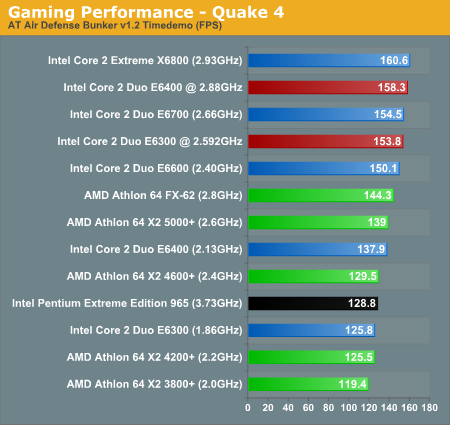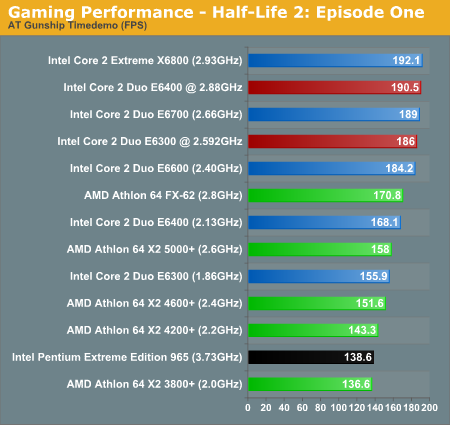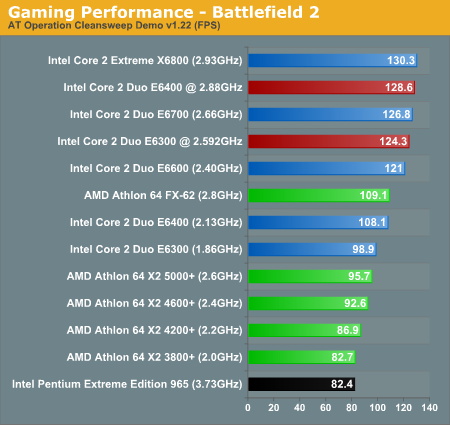Intel Core 2 Duo E6300 & E6400: Tremendous Value Through Overclocking
by Anand Lal Shimpi on July 26, 2006 8:17 AM EST- Posted in
- CPUs
Gaming Performance using Quake 4, Battlefield 2 & Half-Life 2 Episode 1
Our gaming performance analysis starts out with Quake 4 running at 1600 x 1200 with High Quality visual settings. We used version 1.2 of Quake 4 and SMP was enabled:

Once we shift over to gaming performance, the differences between all of the tested systems are greatly diminished. Enabling 4xAA would further reduce the difference, to the point where most of the systems would be about equal. This does not change the fact that the Core 2 Duo chips are able to outperform their AMD counterparts in terms of raw performance, so once faster graphics cards become available we should see the processors begin to differentiate themselves more. Of course, by then we might also have games that are more demanding of the GPU.
Looking specifically at Quake 4 performance -- and remember that this is one of the few games that can truly take advantage of multiple processor cores -- the Core 2 processors continue to outperform their AMD counterparts, but only by a small margin. The overall spread between the X6800 and the X2 3800+ is 35%, which is certainly noticeable, but with frame rates that are all averaging over ~120 FPS Quake 4 is clearly going to run well on all of the tested systems. We had hoped to include Prey performance as well, so that we could see how an updated Quake 4/Doom 3 engine game performs, but we ran into benchmarking issues that we are currently investigating.
Next up we've got the recently released Half Life 2: Episode 1, running at default quality settings (auto detected with a pair of X1900 XTs installed) with the exception of AA and aniso being disabled. As with all of our gaming tests in this article we tested at 1600 x 1200:

In Half-Life 2: Episode One, the Performance spread is 41%. At the top end of the spectrum, we're beginning to become GPU limited even without antialiasing enabled. Valve's Source engine clearly likes the Core 2 architecture, as even without overclocking the E6300 and E6400 clearly perform better than their similarly priced AMD counterparts.

Battlefield 2 is a game that has consistently demonstrated it is more CPU limited than GPU limited, especially with high-end graphics solutions. Here the spread between the processors is 58%, and the E6300/E6400 without overclocking are faster than everything from AMD except for the FX-62. At the top end of the spectrum, we finally begin to reach the limitations of our GPUs, with the top four systems all performing within 3% of each other.










137 Comments
View All Comments
bob661 - Wednesday, July 26, 2006 - link
Give me a break dude the Intel fanbois were doing the same thing. Nothing to see here. Move along.araczynski - Wednesday, July 26, 2006 - link
looks like i'll be gettig the E6600 for great base performance with capability to overclock decently. I'll probably be sticking with a P965 mobo since i won't be going for crazy overclocking or crazy cooling solutions (that turniq cooler looks just about right for my tastes).now i just have to figure out whether to get a 7900gt/gtx/50gtx.... to last me until the second generation of the dx10's comes out...
drebo - Wednesday, July 26, 2006 - link
The pricing in this article is inaccurate. The Conroes are too low and the Athlon64s are too high.Seems to me you're using vendor pricing for one and suggested retail for the other.
coldpower27 - Wednesday, July 26, 2006 - link
No the pricing is completely accurate they are using AMD's price lists that come directly from AMD itself, and they are using Intel's prices for 1000 Unit Quantities, that will also be published on their website.If your talking about actualy price on online retailors that will remain to be seen.
drebo - Wednesday, July 26, 2006 - link
No, I'm not talking about online retailers.I'm talking about actual prices that I can get right now from my distributors and the listed suggested retail prices.
Where, exactly, are you getting your prices?
coldpower27 - Wednesday, July 26, 2006 - link
Go to AMD.com and you can get their official pricing, the listed numbers are what will be on Intel's website when they get updated for Core 2 Duo.OEM Distributer pricing is a different metric.
drebo - Wednesday, July 26, 2006 - link
Distributor pricing is what determines street and retail pricing.Intel can post the MSRP of $999 all they want, but if distributors are selling their products for more than that, the price will never be seen.
What matters is that these prices are not accurate, and paint an entirely different story than should be painted.
goinginstyle - Wednesday, July 26, 2006 - link
Neither are the AM2 prices currently as most places are selling the FX62 well above the $799. So what was your point? It is all about supply and demand, the same thing happened when AMD launched S939, the prices were way over the stated numbers by AMD. You have to start with a base, the published pricing is the base.
drebo - Thursday, July 27, 2006 - link
Genius, $799 is not MSRP for the FX-62. $799 is the price at which AMD sells the processor to its distributors. The distributor then sells the processor to retail and/or wholesale outlets with a markup. The retailers and wholesalers then sell the same product with yet another markup. Currently, my price for an FX-62 is $811. MSRP is near to $1000, but then I, and many other sellers, do not use MSRP. I use cost-based pricing.
I'm not trying to prove anything here other than that the prices listed in this article are incorrect, and that the conclusions drawn are vastly different than conclusions that could be drawn were the pricings correct.
By the way, all prices I've quoted have been for PIBs, not tray processors. I don't use OEM processors...too much liability.
coldpower27 - Thursday, July 27, 2006 - link
And, that's the thing the prices quoted are correct.
Using distributer pricing isn't a good idea as it could vary between the companies, depending on the deal you got as well, those particular prices can't be verified.
The prices listed on this chart can be since they are listed on AMD site and will be on Intel's.
There isn't a choice, unless you wish to use the real world pricing floating around as that is what matters at the end of the day, but there are issues with that, as that fluctuates.